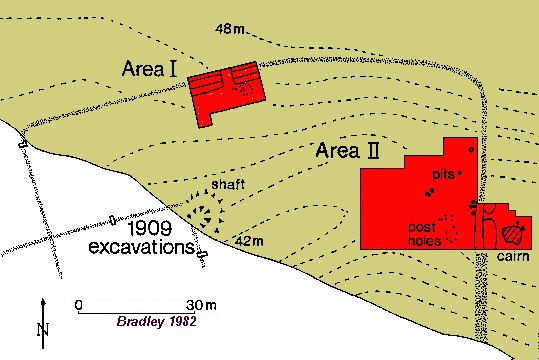
The two small, overlapping rectangular enclosures (B and C), were first surveyed and excavated in 1909 by Herbert Toms. Three sample trenches were opened, struck flint being recovered from enclosure B, flint and Beaker pottery from enclosure C. Toms postulated that enclosure B was the earlier of the two.
 |
Excavations by Richard Bradley in 1968-9, across enclosure C, found the remains of seven possible Early Bronze Age structures, 14 pits, a denuded flint cairn and a number of possible hearths, middens and flint working areas. Five of the postulated buildings were later discounted by Bradley as being structural. |
Two sections were cut by Bradley across the previously unexamined outer enclosure circuit (A) in 1969. In both sections the external ditch consisted of a shallow scoop. Few datable finds were recorded, the conclusion being that the earthworks represented part of an Iron Age promontory fort.
A cliff fall in early 1971 revealed part of a 43m strip of vertical shaft within the cliff, at the approximate centre of enclosure C. The cylindrical shaft (labled pit) possessed a maximum diameter of 1.7m and a series of 'footholds' were detected in the sides of the shaft at vertical intervals of 0.55m. The shaft was further examined on the wave cut platform in 1975 and traced to an additional depth of 0.8m. In 1979 a sherd of Middle Bronze Age pottery was retrieved from an area of shaft fill preserved 20m below the modern ground surface.
Two small excavations were conducted across enclosure A by Owen Bedwin in 1979 and 1980, in an attempt to place the site in context. The bank consisted of a simple, unrevetted, chalk dump, while the area of exposed ditch appeared markedly segmented in character. Finds from primary ditch contexts comprised exclusively of worked flint. Bedwin suggested that the complete lack of Iron Age finds from the enclosure strongly counted against an Iron Age date, while the flints and constructional form of the site would perhaps indicate a date in the Late Neolithic or Bronze Age. An impasse was however created by the land snail assemblage which contained a species of snail thought to have been a Roman introduction.